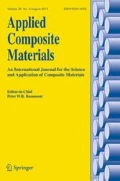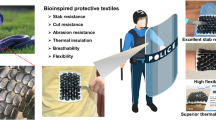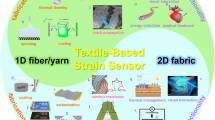Abstract
Characterising the drapeability of reinforcement fabrics, is one of the most sought after abilities of those designing composite processes and components. This is not surprising as composite processes are being considered in a greater range of fields and applications. Drapeability effects are formed by the irregular rearrangement of fibres. This displacement can occur within the textile plane and result in fibre disorientations, undulations and gaps or the fibres can be pushed into the third dimension - forming wrinkles or loops. To measure such effects in non-crimp fabrics, the Textechno Drapetest automatic drapeability tester was developed. To show its viability as a tool for composite engineering, a set of fabrics was chosen to show that the influence of textile design parameters on drapeability effects is now quantifiable. The Textechno Drapetest uses a sophisticated digital image analysis system to measure the position and direction of fibres and conclude from this information on the extent and intensity of drapeability effects in the textile surface. To measure effects outside the surface, i.e. wrinkles, a laser triangulation sensor is employed. The textiles were varied in the production parameters of stitch point distance in machine direction (MD) and cross direction (CD), the weight per area, and the stitch pattern (tricot and chain). The measurements showed that the new test method is capable of measuring the effects that were expected from classical test setups as well as a range of additional effects. From the results a significant influence of the stitch yarn on the formation of effects can be deduced. Especially the density of stitch points is a parameter that lets the textile producer control the behaviour of the textile when they are formed into a doubly curved three dimensional shape. To control the gap formation, however, the spacing of the stitch points in machine or in crosswise direction is also of importance with a shorter stitch length decreasing the forming of gaps more than a tighter stitch yarn pitch.


















Similar content being viewed by others
References
Gries, T., Veit, D., Wulfhorst, B., Schnabel, A.: Noncrimp fabrics. In: Textile Technology München (Carl Hanser Verlag GmbH & Co. KG) 2015 S, pp. 239–251 eBook ISBN: 978-1-56990-566-1 Print ISBN: 978-1-56990-565-4
Creech, G., Pickett, A.: Meso-modelling of non-crimp fabric composites for coupled drape and failure analysis. J. Mater. Sci. 41, 6725 (2006). doi:10.1007/s10853-006-0213-6
Böhler, P., Härtel, F., Middendorf, P.: Identification of forming limits for unidirectional carbon textiles in reality and mesoscopic simulation. ESAFORM J. 554–557
Potter, K., Khan, B., Wisnom, M., Bell, T., Stevens, J.: Variability, fibre waviness and misalignment in the determination of the properties of composite materials and structures. Compos. A: Appl. Sci. Manuf. 39(9), 1343–1354 (2008). doi:10.1016/j.compositesa.2008.04.016. ISSN 1359-835X
DIN SPEC 8100:2015-11: Textiles — Reinforcement textiles — Automatic determination of drapability on woven and non-crimped fabrics for continuous fiber-reinforced materials; published November 2015
Long, A.C. (Ed): Composites forming technologies. In: Woodhead Publishing Series in Textiles. Woodhead Publishing (2007). ISBN 9781845690335
Kowtsch, C., Herzberg, C., Kleicke, R.; Cherif, C. (ed.): Gewebte Halbzeuge und Webtechniken. Textile Werkstoffe für den Leichtbau, Springer Berlin Heidelberg (2011)
Cao, J. et al.: A cooperative benchmark effort on testing of woven composites. Proceedings of ESAFORM, vol. 7. (2004)
Sharma, S.B., Sutcliffe, M.P.F., Chang, S.H.: Characterisation of material properties for draping of dry woven composite material. Compos. A: Appl. Sci. Manuf. 34(12), 1167–1175 (2003). doi:10.1016/j.compositesa.2003.09.001
Krieger, H.: Methode zur Auslegung von Gelegen mit lokal angepassten Fertigungsparametern für Hochleistungs-Faserverbundkunststoffe, Dissertation, RWTH Aachen, September 2015. ISBN 978-3-8440-3908-5
Willems, A., Lomov, S.V., Verpoest, I., Vandepitte, D.: Drapeability characterization of textile composite reinforcements using digital image correlation. Opt. Lasers Eng. 47(3–4), 343–351 (2009). doi:10.1016/j.optlaseng.2008.03.012. ISSN 0143–8166
Lomov, S.V., Barburski, M., Stoilova, Tz., Verpoest, I., Akkerman, R., Loendersloot, R., ten Thije, R.H.W.: Carbon composites based on multiaxial multiply stitched preforms. Part 3: biaxial tension, picture frame and compression tests of the preforms. Compos. A: Appl. Sci. Manuf. 36(9), 1188–1206 (2005). ISSN 1359-835X
Christ, M., Miene, A., Mörschel, U.: Characterization of the drapability of reinforcement fabrics by means of an automated tester. In: Proceedings of SPE Automotive Composites Conference & Exhibition (ACCE), 12. September 2012, Troy, MI
Bel S., Boisse, P., Dumont, F.: Analyses of the deformation mechanisms of non-crimp fabric composite reinforcements during preforming. Appl. Compos. Mater. 19, 513 (2012). doi:10.1007/s10443-011-9207-x
Strauf-Amabile, M., Eckers, V., Gries, T.: Draping of non-crimp fabrics for fibre reinforced composites. Int. J. Mater. Form. 3, 647 (2010). doi:10.1007/s12289-010-0853-6
Miene, A., Göttinger, M.: Digital image analysis for quality assurance in the preforming and draping process. CFK-Valley Stade Convention, Stade, pp. 13–14, June 2007
Christ, M., Herrmann, A.S.: Influence of textile design parameters on drapeability of Warp-Knit NCF; ICCM 20, 20.-24.07.2015, Copenhagen (Denmark)
Author information
Authors and Affiliations
Corresponding author
Rights and permissions
About this article
Cite this article
Christ, M., Miene, A. & Mörschel, U. Measurement and Analysis of Drapeability Effects of Warp-Knit NCF with a Standardised, Automated Testing Device. Appl Compos Mater 24, 803–820 (2017). https://doi.org/10.1007/s10443-016-9555-7
Received:
Accepted:
Published:
Issue Date:
DOI: https://doi.org/10.1007/s10443-016-9555-7




